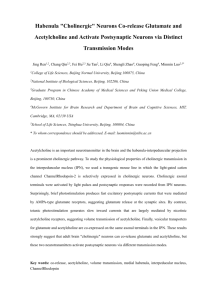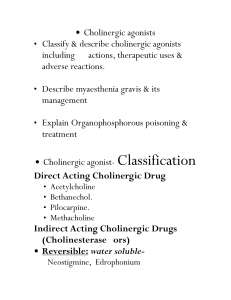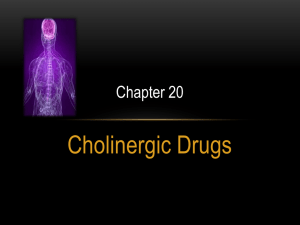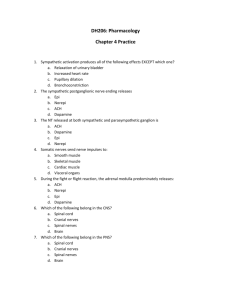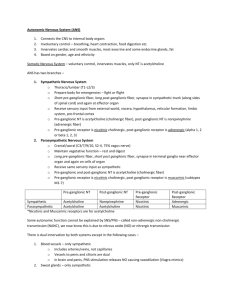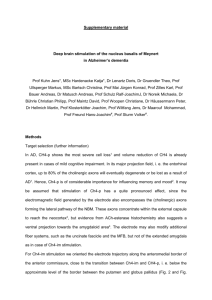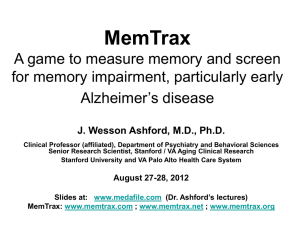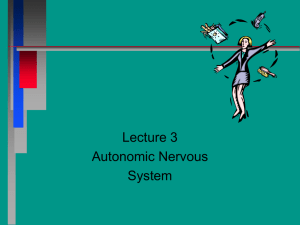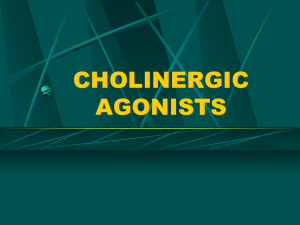Alexander G. Karczmar by Erminio Costa
advertisement
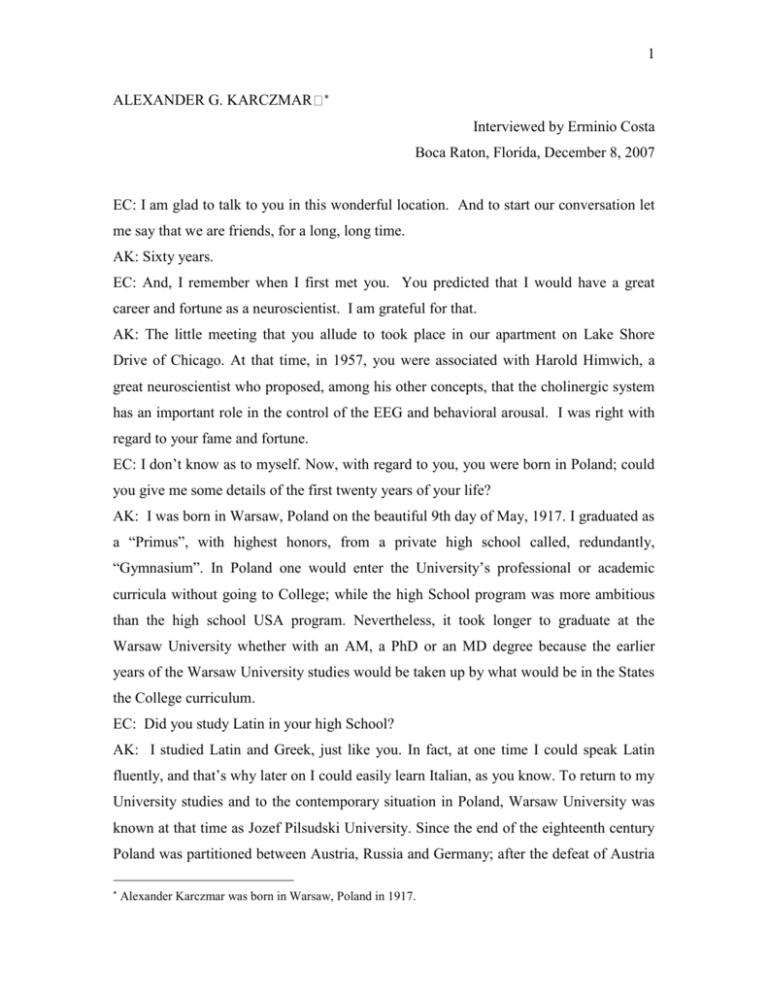
1 ALEXANDER G. KARCZMAR Interviewed by Erminio Costa Boca Raton, Florida, December 8, 2007 EC: I am glad to talk to you in this wonderful location. And to start our conversation let me say that we are friends, for a long, long time. AK: Sixty years. EC: And, I remember when I first met you. You predicted that I would have a great career and fortune as a neuroscientist. I am grateful for that. AK: The little meeting that you allude to took place in our apartment on Lake Shore Drive of Chicago. At that time, in 1957, you were associated with Harold Himwich, a great neuroscientist who proposed, among his other concepts, that the cholinergic system has an important role in the control of the EEG and behavioral arousal. I was right with regard to your fame and fortune. EC: I don’t know as to myself. Now, with regard to you, you were born in Poland; could you give me some details of the first twenty years of your life? AK: I was born in Warsaw, Poland on the beautiful 9th day of May, 1917. I graduated as a “Primus”, with highest honors, from a private high school called, redundantly, “Gymnasium”. In Poland one would enter the University’s professional or academic curricula without going to College; while the high School program was more ambitious than the high school USA program. Nevertheless, it took longer to graduate at the Warsaw University whether with an AM, a PhD or an MD degree because the earlier years of the Warsaw University studies would be taken up by what would be in the States the College curriculum. EC: Did you study Latin in your high School? AK: I studied Latin and Greek, just like you. In fact, at one time I could speak Latin fluently, and that’s why later on I could easily learn Italian, as you know. To return to my University studies and to the contemporary situation in Poland, Warsaw University was known at that time as Jozef Pilsudski University. Since the end of the eighteenth century Poland was partitioned between Austria, Russia and Germany; after the defeat of Austria Alexander Karczmar was born in Warsaw, Poland in 1917. 2 and Germany in the First World War, Polish independence was decreed in 1918 by the allies, led by President Wilson, but Russia did not relinquish its part of Poland, and Jozef Pilsudski fought victoriously against Russia. Independent Poland had first a democratic government and then a dictatorship. This dictatorship, at first tolerant under Pilsudski to religion and to the Jews, became, after Pilsudski’s death, gradually anti-Semitic. This was contemporary with Hitler’s becoming Chancellor in Germany, and in 1937 or 1939 Poland’s regime formed an alliance with Hitler’s Germany. There was an official economic boycott of Jewish businesses, and some “unofficial” violence. Only a few Jews were admitted to the University because of “numerous clausus,” and the Jewish students had to stand up during the lectures, on the left side of the hall. EC: That’s unpleasant! AK: It’s nothing compared to what happened after the Nazi invasion of Poland in 1939. In 1934, I entered the University with a strange curriculum I concocted composed of medicine and biology; I elected not to apply for entrance into the medical curriculum, for reasons too complicated to explain here. After five years of studies and two or three years of what would correspond in the States to graduate work I was ready to graduate but then the Second World War and the Nazi invasion of Poland intervened. EC: That was in nineteen thirty-nine? AK: In the fall of nineteen thirty-nine. To be a Jew and a Pole and to escape and survive what happened in Poland and in Europe after nineteen thirty nine, you had to be very fortunate, and I was lucky enough to be on vacation in Switzerland when the War broke out. EC: And, you never went back? AK: I couldn’t and I shouldn’t and I didn’t. And it was very lucky that I didn’t. EC: Yes, you were very lucky. AK: In fact, my father, a businessman, was also not in Poland when the war broke out and ultimately he managed to get, in due time to New York, as did my mother and one of my uncles, while another uncle, a Doctor, succeeded in getting to Mexico City and establishing a successful practice there; still another uncle was, at the time, my father’s business affiliate in Rio de Janeiro. So, I went first to London, obtained a visa for Brazil and, after one year in Rio de Janeiro, my American “quota visa” became valid. 3 EC: One year in Rio! A nice place for a year’s residence! AK: Yes, but these were dreadful times. A world war, concentration camps, massacres, while I resided safely in Rio. I still have a strong feeling of guilt about it. As I mentioned before, my parents and my uncles on my father’s side were, luckily, out of Poland when the war broke out, but the rest of my family perished in the concentration camps. In the nineteen twenties and thirties very many Polish Jews and quite a few non-Jewish Poles wished to immigrate to the USA. They were listed in the “quota system” and a certain limited number of Poles could migrate to the States each year. So, the list was very, very long, but when the war broke out, my quota number came up relatively rapidly, because very few Poles were in a position of availing themselves of their quota. So, I came to New York from Rio, and I immediately enrolled into the graduate program of Columbia University. I obtained a Master’s degree in the Department of Zoology, chaired by Leslie Dunn, a famous geneticist. Other famous geneticists who taught me in the department were Ernest Meyers and Theodore Dobzhansky, who liked speaking Polish to me. James McGregor, a comparative zoologist and sculptor of several models of primitive men, was also my teacher. Following my MA, my thesis advisor in the PhD Program was Selig Hecht, Professor of Biophysics. His research dealt with the retina, he was well known, and still famous, for his discovery of the quantal response of the retina to photons of light. Also, he wrote a popular book on the atom and its structure. He was also a superb and elegant teacher! I still remember the shock I had, during my first year at Columbia, when I saw one could ask a professor, questions after and during the lecture; that was never done at a Polish University. EC: This was in the nineteen forties? AK: That was between 1940 and 1947, you calculate very well Mimo. I earned my PhD in 1957. But, my thesis did not deal with biophysics, it dealt with limb regeneration in urodeles. EC: Very different. AK: Yes, this shift of mine from biophysics to regeneration is a good example of the zigzaggy nature of my scientific career; you will see other examples of this jumpiness later on. In this case, the shift occurred when I went for a summer to study in the Woods Hole Marin Laboratory. There, I listened to a lecture by Oscar Schotte, a Professor in the 4 Biology Department in Amherst College in Massachusetts, on the regeneration of amputated limbs of urodele larvae that depended on limb innervations. Dr. Schotte was a student of Hans Spemann, a German embryologist and a Nobelist. During the discussion that followed Schotte’s lecture I suggested to him an experiment that would give a clue as to the nature of the factor involved in the nerve dependence of regeneration. Impressed with my suggestion, Schotte, who had a fellowship at his disposal offered me a year’s position at Amherst to work on the experiment I suggested. This study resulted in the first two papers of my career published in 1941 in the Journal of Experimental Zoology. After my expedition to Amherst I did not return to Columbia University as there were no funds available to support me. So, I obtained another fellowship, this time with Professor Alexander Sandow in the Biology Department of New York University. This was another zag in my career as Sandow worked on the skeletal muscle and its latency relaxation (LR). Because of its shape and the name of its discoverer the LR was, referred to popularly as the “Rausche Nase.” I discovered much later that Sir John Eccles with his advisor at the time, Sir Charles Sherrington, co-discovered this phenomenon using a very sensitive lever, but they were not quite sure of their results and did not publish their data. Sandow studied the LR by means of an ingenious piezoelectric lever with a sensitivity of a few micromillimeters and great speed of response; it could measure muscle dynamics such as the LR that lasted only milliseconds. I published with Sandow as well. Then, Columbia found some funds for me and I became a Teaching Fellow in the Department of Biology, and I could turn, with Hecht’s permission, to my early love, regeneration. When I published my thesis in 1946 in the Journal of Experimental Zoology, I proposed that the nerves, irrespective of their type or nature, liberated a trophic substance needed for the regeneration of urodele amputated limbs. I should have stuck to this work which preceded by some fifteen years, the definitive identification of nerve related growth factor by Victor Hamburger and the Nobelist Rita Levi-Montalcini. EC: What were your feelings when you arrived in the United States? AK: In some respects, New York is a very European city, and I felt quite at home. As I mentioned, my parents and one of my uncles lived by then in New York. I felt that New York was the place where people of all kinds meet and where everybody is well tolerated and well understood, no matter the accent, personality or skin color; perhaps, in the 5 nineteen forties, this statement might be an exaggeration with regard to the AfroAmerican population. Then, finally, I became an American citizen and met and married my wife Marion in New York. In fact, obtaining my USA citizenship, the completion of my work on my thesis, and my marriage all occurred in 1946, a memorable and wonderful year for me! So, I was very happy in New York and I felt very much at home. When I accepted a job in Washington, and later when I moved first to Albany and then to Chicago, that was another story and I felt alienated, at least at the beginning of my residence in these cities. Anyway, after I was through with my thesis, David Nachmansohn invited me to join, as postdoctoral fellow, his Columbia University team. EC: In New York. AK: In New York, I had at the same time an invitation from Theodore Koppanyi to join his Faculty at Georgetown University. EC: Georgetown University Medical Center in Washington, DC? AK: In Washington, DC. Of course, the late David Nachmansohn was a very great scientist. If he did not swerve from his discovery of the enzyme he called choline acetylase, known today as choline acetyl transferase (CAT), to stubbornly pursue his untenable speculation that the acetylcholine system underlies conduction of all nerves, whether sensory, cholinergic or adrenergic he would have become a Nobelist. Many famous scientists, Wolf Dettbarn, Sy Ehrenpreis, Ernest Schoffeniels, and, more recently the great Jean-Pierre Changeux, at this time the Director of the Moleculular Biology Department at the Institut Pasteur, were postdocs in Nachmansohn’s laboratory. Nachmansohn’s interest in me was motivated perhaps by my curriculum and grades, but I think his main reason was that he was a good friend and a great admirer of my advisor, Selig Hecht. Anyway, I became, during my interview with Nachmansohn, not very happy with his personality. This was subsequently a bone of contention between my friend Changeux and myself, since Changeux admired and liked Nachmansohn very much, not only on a scientific but also on a personal basis; he published recently a very laudatory biography of Nachmansohn. So, I accepted a faculty position in Theodore Koppanyi’s Department of Pharmacology at Georgetown University Medical School and I moved from New York to Washington. There I pursued my work on regeneration and, in 1946, I applied 6 successfully for NIH support. This was the very beginning of the existence of the extramural research program at NIH; I have had many NIH grants since then. I was awarded an NIH grant just two years ago, so it seems the history of my NIH support is one of the longest. Immediately upon my arrival, Koppanyi launched me on the studies of autonomic ganglionic cholinergic transmission and, from that time on, I stayed almost exclusively with the cholinergic nervous system. We worked on the ganglionic nicotinic transmission which Koppanyi and I evaluated with anticholinesterases, including physostigmine and organophosphorus (OP) agents, and cholinergic agonists and antagonists. This led to the novel concept of direct action of aniticholinesterases, both with regard to their facilitatory as well as blocking effects on nicotinic stimulation of the ganglia, and with regard to their potentiation with small doses and blocking with large doses of the nicotinic effects of acetylcholine. We postulated that these direct effects were due to the direct actions of anticholinesterases on ganglionic nicotinic receptors, these actions being independent of their enzymic effects. We also studied the role of blood cholinesterases, which remains enigmatic even today. We proposed that the enzymes we referred to as “transport” cholinesterases served to protect the organism from endogenous choline esters. One day, as Koppanyi saw me working with urodele larvae and when he discussed this work with me, we realized that these animals, which obtain oxygen as they swim underwater via their skin, may also absorb drugs through the skin. So we studied what we called the “overt” behavior of the urodele larvae, particularly under the influence of physostigmine, and we distinguished between what appeared to be an ‘alerting’ effect of small doses of anticholinesterases and convulsive effect of large doses. After seven years with Dr. Koppanyi I moved to the Sterling Winthrop Research Institute in Rensselear, New York, a suburb of Albany. EC: But, you liked Washington DC? AK: After living with Marion for a few months in Washington I begun to like Washington very much, until the era of McCarthy that you may remember. During most of my work with Koppanyi, Washington was a very liberal, progressive, cultured city, with parties all over the place, including those given by various embassies, and entry into 7 the parties was quite easy. With the advent of the McCarthy era the interaction ceased and nobody spoke to anybody; everybody was afraid of everybody else. EC: Especially in Washington, DC. AK: It was not a very pleasant time in Washington. But, Theodore Koppanyi was a great master and a great pharmacologist. He was also eccentric; Koppanyi stories abound still today. I remember that whichever discovery was mentioned to Koppanyi, he would say that he discovered it first and he would pull up a reprint to prove the point. He was also a very great friend of your ex-boss, Steve Brodie. They were very close. EC: But they were two different types. AK: Indeed! They were both eccentric and creative, but Koppanyi was more eccentric than creative, and the reverse was true for Brodie, who was always much more persevering as a scientist. EC: Both were extremely intelligent, and Brodie was a genius. AK: Brodie was a genius, who deserved the Nobel Prize but never got it. The great writer and philosopher, Arthur Koestler listed in one of his books Koppanyi as one of the Wunderkinder in his adopted city, Vienna (Koestler was born in Budapest). In Vienna Koppanyi published a number of papers on eye regeneration, with no less a luminary than Paul Weiss. In fact, the gossip was that Koppanyi was to get the Nobel Prize for eye regeneration, except that as he was to demonstrate at a Congress the functional recovery of the amputated eye of a rat, just like Otto Loewi had to demonstrate at a Congress the cholinergic nature of the vagal transmission. Koppanyi’s demonstration was a flop! So, when Koppanyi came to the States in the early nineteen twenties, he abandoned work on regeneration completely. He worked at Cornell University with Hatcher on defecation and other autonomic functions, and then on ganglionic transmission and on barbiturates. EC: You have a good recollection of the time with Koppanyi? AK: Yes, because he was such a strange character and so catholic in his tastes. In Georgetown, I developed several friendships that lasted a life time. I met George Koelle, a world-famous “cholinergiker” and the developer of histochemical stains for butyryl and acetyl-cholinesterase, when he came to Georgetown to deliver a lecture. We developed immediately a friendship that lasted till George’s death 5 years ago. Bo Holmstedt, subsequently a renowned toxicologist and forensic scientist, worked at the time on a 8 Fellowship with George Koelle at the Philadelphia University Medical College. Bo liked to come to Washington on weekends, because he felt that Washington was very cosmopolitan and cultural; we became close friends and remained so till Bo’s death. I said at the time to George, “You know Bo really doesn’t like Philadelphia”; George could not get over it, because as a born and bred Philadelphian he loved his City. Anyway, after 7 years with Theodore I received a good offer, money-wise, from Maurice Tainter, Director of the Sterling Winthrop Research Institute. My other inducement for accepting the offer was that several well known scientists, like Al Lands, Froilan Luduena and James Hoppe, worked at the Institute. EC: How long did you stay there? AK: Three years. I felt after three years that the corporate and pharmaceutical laboratory life didn’t agree with my character. So I moved. EC: Too many rules? AK: That’s right. And, too much intra-Institute intrigue. EC: Research, even in a good place in industry, is quite difficult because of the priorities. AK: If you don’t discover a miracle drug for your company your name is mud. Well, I did develop, or help develop a couple of drugs that are still in use. Ambenonium (Mytelase) was developed by Al Lands and me as a treatment for myasthenia gravis. Myordil was, or is used, as an antiarrhythmic drug. Finally, I worked on a benzoquinonium derivative that appeared, in animals, to be an effective mild antipsychotic; unfortunately, the Institute did not, at the time, have the capacity for clinical testing of this drug. In fact, I developed at the Institute a battery of tests for the development of antipsychotics; it included a test in the monkey that I developed on the basis of Charles Darwin’s book on facial expressions of mood in man and monkeys. And, I got the Institute to purchase from Joseph Brady an automated device for quantitating conditioned learning in mice and rats. This was copied by other pharmaceutical companies, as any pharmaceutical company was glad to purchase this equipment as it worked at night, saving the company precious time. Altogether, I did quite well at the Institute; nevertheless, I think that Tainter did not quite approve of me, and, at one time he almost fired me. This happened when I went with Tainter to visit the famous neuroscientist, Karl Pribram, Director of the Institute of Living in Hartford, to seek his 9 opinion of our program. When I explained the program and our tests to Pribram, he said: “I would not compliment these trials with the term ‘tests’ “, and Tainter got very upset! I would like to stress that I worked out a couple of novel concepts at Sterling-Winthrop I am proud of. I demonstrated that a congener of Ambenonium, an oxamide, exhibited what I referred to as “sensitizing” actions at the neuromyal junction that were receptorbased and not related to any anticholinesterase effect. I published this novel concept simultaneously with Steve Thesleff’s description of the reciprocal, “desensitizing” action, also referred to as receptor inactivation. And subsequently, together with John Paul Long, later the Chair of Pharmacology at Iowa Medical College, I demonstrated, in 1955, that muscarinic CNS receptors are structurally identical with the autonomic, peripheral muscarinic receptors. After Eccles’ demonstration in 1954 of chemical cholinergic transmission at the spinal cord’s Renshaw cell, this was an early evidence for the presence of muscarinic transmission in the CNS. EC: After three years you went where? AK: In 1956, I became the Chair of Pharmacology at Loyola University Medical Center. The Department was located in a pre-Chicago fire building that was about the oldest building in Chicago, infested with rats. When I arrived, the Dean of the School, Dr. Sheehan, told me that they were just ready to move to the new building, and I said, “You don’t have to reassure me you are going to move to the new building; how can you possibly continue to have a Medical School in this building”. But, it took him eight years to fulfill his promise. Chicago was the place where I met you. EC: We met because Brodie was our mutual friend. Anyway, you were very, very successful as a Chairman of the Department. AK: You mean, administratively. EC: Also scientifically. All your staff said you gave them freedom and support with regard to their research. AK: Before me there was no Department of Pharmacology at Loyola University Medical Center (LUMC). The late Thomas Ivo Oester, who became chair of a department in the late nineteen forties, for not being able to do much for his Department which, before him, was alternatively moribund and non existent since it was established around 1910 (my history of the Department is available in the Archives of the Library of the Loyola 10 University), as he was very busy heading a laboratory specializing in the saliva test for race horses, and being Associate Chief of Staff for Research at the Hines VA Hospital. When I arrived at LUMC I applied for a training grant to NIH and the late Lou Goodman, chair of the pertinent Study Group said in his evaluation of my application that Karczmar is a good man who is trying to revitalize a defunct department. Parenthetically, I got the grant, as well as the first of many NIH, NSF and Department of Defense grants for the cholinergic studies. The training grant helped me to recruit two good researchers and excellent teachers, Alex Friedman and Joe Davis to the Department. Alex was a pioneer of the studies of circadian rhythms, and Joe, who started as a NIH awardee in ontology, found his own corner when he discovered a new organ, the testicular capsule, and defined its autonomic control. They were also very gifted teachers. And then, slowly but surely, the Department grew in reputation and attracted young scientists who were well known then and even more so subsequently. This was a very international team! It included Kyozo (Kyo) Koketsu, a co-author with Eccles and Fatt of the Nobel-prize winning paper on the cholinergic transmission at the Renshaw cell; Syogoro Nishi who was a Rockefeller Fellow when he joined my Department; Alan North, a student of Hans Kosterlitz, the pioneer of the endorphins studies at Aberdeen, Scotland; Bob Jacobs, a graduate of the University of Wisconsin and a specialist in neuromyal transmission; Les Blaber, a student of Bill Bowman of London University, world-known for his neuromyal studies; more recently, Stan Lawrence, a well-known psychopharmacologist, and Luke van de Kar, a Berkeley post-doc in the area, believe it or not, of serotonin transmission. John Eccles became an Adjunct Professor in the Department in sixties. He participated in our seminars and advised our graduate students. Another Adjunct Professor was the late Guy Everett of Abott laboratories, the discoverer of tremorine and its parkinsonian-like effects. We had distinguished foreign fellows, such as Vladimir Skok from Kiev, Gordon Lees of Aberdeen and Vincenzo (Enzo) Longo of Rome, and we collaborated with members of other Departments of LUMC and of the Hines VA Hospital. My VA associates included Volia Liberson, an famous physiatrist, EEG expert and neuropsychopharmacologist, who was a student of Pavlov; Alfred Kahn, a student of addictions and Joseph Bernsohn, a neurochemist and specialist in tranquilizer research. At LUMC, I collaborated with Abe Rosenberg, the Chair of Biochemistry. I 11 should also mention my Senior Assistants, Gizela Kindel and Lionell Barnes who worked with me for twenty years and participated in all kinds of studies. So, we had a very successful Department, focusing on neurosciences and neuropsychopharmacology. With the help of LUMC and the Illinois Department of Health we managed to establish, as part of the Pharmacology Department, the Institute for Drugs, Mind and Behavior. EC: Where you studied cholinergic mechanisms. AK: Mostly. All my scientific life I was in love with cholinergic mechanisms, and I am quite chauvinistic when it comes to cholinergicity. At this meeting of ACNP I am upset because all I hear is about dopaminergic, serotonergic, GABA-ergic and peptidergic phenomena, and nobody mentions the cholinergic system. Fortunately, we have now regular meetings of a cholinergic society, the International Symposia on Cholinergic Mechanisms (ISCMs). as well as Symposia on cholinesterases (ChEs) and on Alzheimer Disease (AD), led by such luminaries as Mirko Brzin and Elsa Reiner in the case of ChE Symposia and, in the case of AD, my successor at LUMC, Israel Hanin. The ISCMs were initiated by Edith Heilbronn, a German born famous Swedish scientist, who felt in the nineteen sixties as I do today, that the cholinergic system is neglected. We have had, by now, twelve ISCMs, and the thirteenth ISCM will take place in Brazil. EC: I believe I attended one or two of them. AK: You attended the Florence ISCM, and, in fact, you insisted that the organization provided a limousine to drive you from the airport to the site of the meetings, which we happily did. You presented your pioneering method to measure acetylcholine turnover and evidence about the effect of functional states on turnover. You felt, quite rightly, that acetylcholine turnover is more important as a marker of functions and behaviors with cholinergic correlates than acetylcholine levels. To return to the Department of Pharmacology at LUMC, when Kyo and Syogoro returned to Japan to become the president of Kurume University and the Chair of Physiology at Kurume, respectively, we continued our collaboration on ganglionic, neuromyal and central transmission, and several Kurume postdoctorals, including Yoko .Ohta, K. Akasu and K. Kaibara, joined us for a year each to help us with this work. Together, the LUMC-Kurume team established receptor sites at the autonomic B ad C neurons, and enteric and parasympathetic ganglia; and we defined at these sites the fast 12 nicotinic and the slow muscarinic potential, and the extra-slow peptidergic and the inhibitory potentials. This work resulted in a book, “Autonomic and Enteric Ganglia“, published by Plenum Press in 1986. Independently, we followed my earlier work on receptor modulation which would be today defined as an allosteric conformational change, and we described NaF, studied earlier by Edith Heilbronn, as a reactivator of organophosphorus anticholinesterases-inhibited acetylcholinesterase, a potent sensitizer of cholinergic transmission, both centrally and peripherally. I also continued behavioral work, with the association of the late Charles Scudder, my very brilliant graduate student. With him, Volia Liberson and Enzo Longo, with whom I worked previously in Rome where I was a Guggenheim Fellow at the Istituto Superiore di Sanita, we defined cholinergic EEG and behavioral arousal, and demonstrated the cholinergicity of REM sleep. Volia and I also demonstrated the cholinergic “cure” of “obsessive animal behavior,” using the “no goal” paradigm. With Charles Scudder and my assistant Gizela Kindel we developed an automated multilever two-way conditioned learning device for the study of learning in mice, and a big enclave into which we released all kinds of genera of mice, to study ethological, “normal,” mouse behavior. George Koelle called this enclave model, “the mouse city”. EC: You had games for the mice! AK: Yes. And, George, alluding to the politics of Chicago, said that at one time I discovered that the elections in the “mouse city” were rigged; so I closed “the mouse city”. Well actually, Charles and I did not close “the mouse city”. In “the “mouse city” we could quantitate every ethological behavior, such as exploration, maternal protection of the pups, three or more types of aggression, predatory, consumatory and territorial, social behaviors, such as grooming, etc. We studied the effects of drugs, cholinergic and non-cholinergic, on all those behaviors as well as the relation in the various genera of mice between these behaviors on the one hand and genetic and transmitter characteristics on the other. We linked the cholinergic activation, cholinergic neurotransmitter profile and certain sites within the cholinergic pathways in the brain to learning and aggression. Altogether, this work led me to define the role of the cholinergic system, in animals and humans, as the facilitator of “realistic” cognition of the outside world. Thus, the cholinergic system is necessary for the realistic interaction between an organism and the 13 environment. I called the pertinent cholinergic syndrome, Cholinergic Alert Non-Mobile Behavior (CANMB). EC: You were right, because the brain has a central master director, the cholinergic system, especially in the case of the limbic system, the brain stem, and the hypothalamus. AG: Thank you. Yes, hypothalamus, the hormones and the cyclic hormonal rhythms, with the reciprocal interaction between these rhythms and the cholinergic system are functionally and behaviorally most important, particularly for sexual behavior and thermocontrol. The important question here is, how does the cholinergic turnover change when progesterone, testosterone and estrogen levels go up and down during the diurnal, seasonal and sexual cycles, and vice versa. We provided a few answers to this question, but it’s for future investigations to fully clarify the matters. I am quite proud of positing the concept of the CANMB. I wrote a number of review papers on the role of the cholinergic system and of CANMB in counterbalancing schizophrenia in the human and animal models of schizoid behavior. I know that you and Sandro Guidotti stress the role of the GABAergic system in schizophrenia, but perhaps there is an interaction between these two transmitter systems in the generation of schizoid behavior. EC: Altogether, your Department specialized in neurobiology. AK: Yes, neurobiology, rather than neurosciences. But, we formed, within the Department, the Institute for Mind, Drugs and Behavior devoted mainly to neurosciences. My late, talented friend, Charles Scudder, served as the Associate Director of the Institute. Also, we studied cholinergic ontogeny and ontogenetic and morphogenetic effects of cholinergic agents and anticholinesterases. With Joe Bernsohn, we showed that anticholinesterases cause a shift in the ontogeny of isozymes of cholinesterases, which is important with regard to the effect of anticholinesterase treatment of pregnant mice on postnatal behavior, such as aggression, of the offspring. I continued these studies after resigning from my chairmanship, as the Senior Fullbright Fellow at Bill McGuire’s Institute in Sydney, Australia. With Bill, the discoverer of the human thalidomide ontogenetic malformation, we investigated the ontogenetic effects of administration of organophosphorus (OP) agents to pregnant rhesus monkeys. This is a matter of great importance in Australia, in view of the energetic, agricultural use of OP agents as 14 pesticides in Australia. Altogether, this work confirmed my earlier concepts of a direct morphogenetic action of cholinergic drugs that is initiated in the embryo before the onset of neurogenesis, and of the trophic and morphogenetic role of the cholinergic system during development. So, the cholinergic system is important for both morphogenesis and the control of interaction between neurogenesis and ontogenesis of functions and behaviors. EC: Also, it is very important to investigate how during development these interactions are orchestrated. Central neurogenesis is fundamental in being the master of this interactive concert. AK: You’re right. This interaction concerned early students of the cholinergic system, including David Nachmansohn, Zenon Bacq and Charles Sawyer. They were interested in neurogenesis and phylogenesis of the cholinergic system in several species and their relation to function, such as motility. Their studies were carried out prior to the demonstration of central cholinergic transmission in the nineteen fifties. Eccles, Sawyer, Bacq and Nachmansohn felt that the presence of a strict relation between cholinergic ontogenesis, neurogenesis and ontogenesis of function, would demonstrate the chemical, cholinergic nature, of neurotransmission. Today we know that presence of the cholinergic system in an embryo is very precocious with respect to neurogenesis and the development of function! EC: Nachmansohn’s greatness lies in his discovery of choline acetyl transferase. AK: Yes; we mentioned this fact already. He also described acetylcholinesterase as one of the most rapid, if not the most rapid, enzyme in existence. Then, he pioneered the studies of acetyl CoA; as we mentioned before, he should have got the Nobel Prize for this and his other work, but unfortunately he stuck to his idea of the role of the cholinergic system in conduction of all cholinergic and non-cholinergic axons, and worked for years trying to prove this speculation. This was indeed bizarre, and I feel, and I was told, this endeavor lost him the Nobel Prize. EC: He was really denying progress. AK: He was very stubborn. Let me tell you an anecdote which is pertinent. Nachmansohn participated in a 1959 Symposium in Rio de Janeiro and during a break, he went to the beach where he fell asleep in his chair. So, Eccles and others started pushing 15 Nachmansohn in his chair into the sea. Nachmansohn wakes up in the middle of this activity, sees himself deep in the water, and says: “You can kill me but you cannot kill the theory”. EC: Much can be said about him, but he was a very intelligent and creative person, more intelligent than many people around him. He held in close control his laboratory, and made his associates work hard to provide evidence for his speculation, whether they believed in it or not. He was always thinking about the brain as a whole that obeys the same physical and chemical laws whatever the site or type of neurons, axons and dendrites. AK: As I alluded to before, he left behind him a number of very able men. . Speaking of Ehrenpreis, at the same Rio Symposium I mentioned, he described a cholinergic receptor of the electric organ of Torpedo, as did, somewhat differently, Ada Hasson with Carlos Chagas, the son of Carlos Chagas of Chagas Disease. Before their studies, for many years, our idea of the receptor was abstract, because it was based on structure-activity relationship (the SAR) of compounds that exhibited affinity for a given receptor, and not on any direct description of their nature. No one really envisaged the receptor as a chemical molecule. EC: That was true not only for cholinergic but for all transmitters! AK: Quite right, and Bob Furchgott, who earned a Nobel for his SAR studies opined that we will never get a chemical image of a receptor or obtain a transmitter molecule! So, when at this Rio de Janeiro meeting, Chagas, Hasson and Ehrenpreis spoke of isolation and purification of a receptor, in this case, a cholinergic, nicotinic receptor, we were all flabbergasted! It transpired later that both Chagas with Hasson and Ehrenpreis got their receptor wrong. Jean-Pierre Changeux, Nachmansohn’s postdoc as I already mentioned, who was personally very fond of Nachmansohn, liked to stress that Nachmansohn did not appear as an associate of Ehrenpreis, at Ehrenepreis’s Rio presentation, because Nachmanson did not believe in Ehrenpreis’ results. Changeux did not want his idol to be accused of being wrong on this matter! We studied, with Joe Bernsohn, Gizela Kindel and Abe Rosenberg the metabolism of acetylcholine during development and aging. Under your influence at that time, we also studied the acetylcholine turnover, because we followed your concept that 16 transmitter turnover levels are more important in diagnosis of behavior than transmitter levels. We showed that with the decrease of the pool of acetylcholine synthesis in old mice, there is a compensatory increase in incorporation of choline in the synthetic pool of acetylcholine, and in acetylcholine turnover. Since the nineteen sixties I have had a chance to review our different studies in a number of Journals, after my retirement from the Department Chair at LUMC. I did not do much experimental work later, but I continued with my review work; I published several of my reviews in Journals where you served as the Editor. I also organized several Symposia, participated in meetings, including the ISCMs and ACNP, and I was busy working on my book, Exploring the Vertebrate Central Cholinergic Nervous System. The book serves as a maxi- review of our past work as well. EC: When did it come out? AK: In 2007, this year. This is essentially a one-author work, although out of its eleven chapters three are collaborative. I sense that in regard to its scope, it is a unique opus. It stresses the history of the cholinergic system, and it proceeds from shamans and hunters, and prehistoric use of cholinergic medicinal plants to the current status of CNS cholinergic research. It took me eight to nine years to put it together. There are many multicolored photographs in it, including three-dimensional and dynamic illustrations of cholinergic receptors and cholinesterases, schemes concerning acetylcholine synthesis, and designs linking cholinergic pathways with specific functions and behaviors. You don’t need this book to be immortalized, but there is a color photograph of Dr. Erminio Costa, Dr.Gian-Carlo Pepeu of Florence and his wife, the doctoressa Ileana, Dr. Israel Hanin, a prominent cholinergiker and discoverer of a chemical assay for acetylcholine and my successor as the Chair of the LUMC, Department of Pharmacology and his late wife, Leda. There are many other photographs of the present and past great cholinergikers, from Otto Loewi and Henry Dale to Mona Soreq and Rita LeviMontalcini. So, this is quite a book, if I say so! EC: Writing this book required so much of your stamina, effort, and emotions. How could you write this without emotion, living again through all your own research and that of your friends? 17 AK: Well, it’s true. I’m ninety years old, so I am a full-fledged participant in the great story of continuously ongoing cholinergic research. Fortunately, there are many questions not answered as yet, that might be answered in the future. EC: Who is the publisher? AK: Springer, New York. EC: This is just out and the great Victor Whittaker is author of the Foreword. AK: Just out, just out. EC: This is a beautiful book. AK: Very beautifully edited. It has a color photograph of a Himalayan peak symbolically representing the fact that, unlike the Roman Empire which rose and then fell, the studies of the cholinergic system rise but never fall. EC: How many years did you spend at the LUMC? AK: I was Chairman for thirty years. To be a Chairman of a Department of Pharmacology for thirty years means you are crazy. I retired as the chair about twenty years ago, but I continue serving as a consultant to the Veterans Administration and the Defense Department of the United States of America. EC: Have you been in Georgetown recently? AK: No, not recently. EC: Georgetown used to be a beautiful Washington area where people could play, but, now, it is a city. There is a rule that Georgetown University students have to live in Georgetown. AK: Georgetown University is a beautiful university because there is a big campus, and within it there is a shady, wooded valley separating the University from the Medical School. One could walk or jog from the University to the Medical School. Within the valley, there is a cemetery with the old tombs of Jesuits fathers, members of the University. But, you are right; Georgetown is now a City. You know this very well, as you served for so many years as the Director of the Fidia-Georgetown Institute. EC: I think the Medical School is still controlled by the Jesuits. AK: This reminds me of a point I would like to stress with regard to Loyola Medical Center. When I entered the Department, the school was controlled by the Jesuits but now, the LUMC is an independent entity. During my time the Jesuits and the President of 18 LUMC controlled it fiscally and administratively. They were, and are, very tolerant. Among some Jews who served as Departmental chairs or Professors at LUMC, I’ll not deny I was rather strange or eccentric in my behavior; I think the Jesuits were more tolerant than any other university would have been, of my, shall we say, eccentricity?. Jesuits are wise people; they are an old and sophisticated organization, devoted to learning. Jesuits know all about human vagaries, and they accepted me the way I was. EC: From all the time that you spent at Loyola University, what do you remember? What are the strongest memories, from your professional and the human viewpoint? AK: On its 100 year anniversary, in 1969, Loyola University instituted a great celebration. EC: So, the Chicago LU was inaugurated in eighteen sixty nine? AG: Right. I was invited by the Chancellor, Very Reverend James Maguire, and his Council to prepare, as a part of the celebration, a symposium that would be appropriate in its themes with the Jesuit ideals of unity between knowledge and religion. All the costs of the symposium, including the travel of the participants and their honoraria, were covered by the LU. Jointly with Eccles, who, as I already said, was an Adjunct Professor in my Department we organized a symposium entitled Brain and Human Behavior, the proceedings of which were published by Springer Verlag of Berlin in 1972. At the symposium, we had philosophers like Steve Tulmin of Brandeis University and Ernan McMullin of McGill University who discussed the mind and the brain from the philosophical and epistemological viewpoint. Then, there were psychologists, such as the famous Jean Piaget of Geneva University and notable neuroscientists, including Holger Hyden of the University of Goteborg, Eduardo de Robertis of the University of Buenos Aires, Seymour Kety of NIH and Boston General Hospital, Michel Jouvet of the University of Lyons, Igor Beritashvili (Beritoff) of the University of Tbilisi and Sam Barnett of Australian National University. The Symposium was unique because three of its participants were Nobel Prize winners: Danielle Bovet, John Eccles and Ragnar Granit. They were sitting on the same bench and didn’t bite each other! And many other cholinergikers were present. EC: This was one of the greatest scientific gatherings that ever occurred in an American school. 19 AK: You’re the one to know; you organized a great Symposium for the inauguration of the Fidia Institute. Also, I was very proud, professionally speaking, to establish a great department. I should stress that throughout my tenure, we had an outstanding body of graduate students; a long-standing NIH Graduate Training grant was instrumental in this. Our graduate students worked with us, published with us, and many of them became my close friends, such as Nae Dun, Chair of Pharmacology at Temple University, Sam Speciale of NIH, Luke Konopka, Chief of the Neurosciences Laboratory at Hines VA Hospital, and Joel Gallagher and his wife, Pat Shinnick-Gallagher, both Professors at Galveston University Medical Center. EC: Let’s go a bit further in your life. You had a number of people working with you. In whom did you most imprint your way of thinking? AK: There are a number of great guys who came out of our laboratories. It’s very difficult to say who is best. Nae Dun, is an extremely able neuroscientist, both in terms of neurotransmitters and molecular activity of enzymes on the one hand and function on the other. He likes to use, after me, Jewish-Polish expressions, such as “Schnook”.I think he learned from me the art of grantsmanship…Experimentally, I may have taught him to ask big questions rather than stick to what an advanced technique may deliver, and also, to be skeptical. His favorite statement is; “how come”? Another graduate student of mine, Charles Scudder, whom I already mentioned, accepted a faculty position after his graduation and became a close friend of Marion and myself. He was most eccentric and at one time he tinted his hair purple-red, to the great discomfit of his colleagues on the faculty. He also had a pet monkey. He bought an old mansion on West Adams Street in Chicago, in the middle of the black ghetto, because he needed a big house to install the baroque furniture he purchased when the old Balaban Cinema palaces went on liquidation sale. To top all this, he was a professional level harp player who was invited to join the Chicago Orchestra. I am not kidding! Fortunately for me, he preferred to stay with science. He had some original ideas about unity of the universe and published the results of some experiments designed to prove his speculations. He retired early, as he wished to be in full strength to be able to build, with a couple of friends, a mansion he designed himself, in the wilderness of Georgia. Then, a tragedy struck, when he was killed by a couple of marauders. Then there were Kyo Koketsu and Syogoro Nishi. Of course, when 20 Kyo joined us he was a mature scientist. He worked earlier with Eccles and subsequently he has had his own laboratory at the University of Illinois, but we soon became close friends and collaborators. Similarly Syogoro came to me as a Rockefeller Fellow and in our laboratories he worked originally with Kyo, but, when Kyo left to become the President of Kurume University we became close, as friends and collaborators. The three of us published a number of papers and reviews and were the co-editors of the book on “Autonomic and Enteric Ganglia”, which I already mentioned. Syogoro and Kyo taught me to be patient carrying out experiments. They developed a very delicate synaptic in vitro frog preparation that took a whole day to work out. Whenever there was any sign of damage or bleeding during the dissection they would stop and wait and wait and wait till everything returned to order, and they would start recording after most of us had left for the evening. This patience, this delicacy of touch, this persistence, always astonished me. It may be impossible for a European or an American, for me and possibly for you, to achieve that degree of patience. We’re too temperamental! EC: One person that was capable of this was Floyd Bloom. I never saw someone so persistent. AK: Floyd Bloom is a good example. There is another stunning preparation that Kyo and Syogoro developed; the bullfrog lung assay for measurement of acetylcholine concentrations. Now we have all kinds of chemical methods for the measurement of acetylcholine, such as the gas chromatography-mass-spectroscopy technique established by my successor in the Department, Israel Hanin, and the chemoluminescence method, even more sensitive, developed by Maurice Israel and Yves Dunant. But the bullfrog lung assay was more sensitive than all our chemical methods. I think it was sensitive to ten to minus twenty-one milligrams. EC: It all depends on the volume of the bath in which you put the assay organ. AK: I guess you’re right! I shared with Syogoro and Kyo their interest in Japanese culture, in Shintoism, Buddhism and art. Minako Nishi was an exquisite koto player and we spent many evenings listening to her playing original Japanese music. Then there was Alan North, whom I mentioned before. Besides being a great neuroscientist he was a great climber; he climbed in Scotland and the Alps, and he also was a participant in an English expedition to the Himalayas, where he froze a couple of his toes which had to be 21 amputated. We shared the mountaineering interest, although my climbing was miniscule compared to Alan’s. And Alan was, and is, very sophisticated and worldly. Marion, Alan and his first wife Valerie established a good and jolly social relationship. EC: Where is Alan North now? AK: He is Vice President for Reasearch at Birmingham University in the UK. After leaving us, he became Chief of the Institute in Portland Oregon, and then he was a section chief of Glaxo Drug Company in Geneva. He left me to get better money, but I love him anyway! I have an interest that I did not share with my students or associates. This interest concerns the study of the “self,” and I don’t mean cognition. EC: Do you differentiate between cognition and the subject the Romans referred to when they said; “Learn about yourself”? AK: It is the “self” or the “I” I am talking about, the Greek term, not necessarily the Latin term. Cognition concerns learning and memory, and, perhaps, perception. Cognition is a behavior, just as aggression or addiction. Cognition and other behaviors can be explained quite well in neuroscientific terms. The brain sites, circuits, transmitter pathways and transmitters involved, all the physical and chemical phenomena pertinent to these behaviors, are well defined. But the “self” is not cognition; the self is the feeling of “I”. You have no doubt that you are you, Mimo, and I have no doubt that I am I! Yet, what is the “self”? Since the days of Heracleitus, Democritus and Cartesius this problem occupied many minds, both scientists and philosophers. We can classify them as reductionists or dualists. The reductionists or monists think that, just like behaviors, the “I” can be reduced to physics and chemistry, and to the material brain, and the dualists opine that the brain phenomena and the “I” are two separate entities. Today, when we know so much about the brain and behaviors, this topic is discussed with more sophistication than ever before. This is a very popular subject today, and the Churchlands, Changeux, Smythies, the Nobelists Crick and Edelman, Llinas and many others deal with it vehemently. Many of them consider cognition as consciousness, and consciousness as similar or identical with the “self.” They do not offer clear differentiating definitions as to the “self” versus consciousness. They attribute the “self” and other mental phenomena such as cognition or aggression to the functioning of the 22 cortex and/or other parts of the brain. But, many philosophers, who are concerned with these matters say the “self” is an epiphenomenon, although they hate to be called epiphenomentalists. For instance, the great American philosopher, John Searle, claims the “self” is a characteristic of the central nervous system, like digestion is a characteristic of the intestine. That’s exactly the metaphor he uses. EC: Oh, my God! AK: Oh, my God is right. John Searle is a renowned and respected philosopher, but this doesn’t make any sense. I agree that digestion is a product of the action of intestinal enzymes and juices, but the “self” does not, to me, result from neuronal and transmitter phenomena that we can describe. EC: But, the product remains as the important phenomenon: the intestine produces shit and the brain produces the “self”! AK: Yes, but the question is how do they manufacture their products? The Sherringtonian Society I am a member of, instituted by Sherrington’s student Jack Eccles, is concerned with this problem. The great Charles Sherrington in his book Man on His Nature described what the “self” is compared to consciousness. He was a theist, and therefore a dualist, as was that other theist, his student Sir John Eccles. At any rate, the Sherringtonian Society is very much interested in solving that conundrum. The problem is complex, and I’m simplistic describing it here. I cannot do it otherwise in this short interview. As a scientist I am of course a reductionist, but I also sense we do not have, as yet, all the data needed to “reduce” the problem. In the Introduction I wrote for the book, The Brain and Human Behavior I say we are a hundred years too early to answer the question, what is the “self”? Since that book was published some forty years ago, we still have sixty years to go to solve the problem in reductionist terms. I opine that the current approaches of “reductionists” even when more sophisticated than Searle’s are still unsatisfying and premature. Thus, Changeux in his recent book that bears a challenging title, “The Physiology of Truth” describes states of consciousness clearly, impresssively and neuroscientifically, but his relating these states to the “self” suffers from the same sins I ascribed earlier to modern reductionists or monists. A specific, Eureka-kind speculation is needed to breach the gap between consciousness and other behaviors on the one hand, and the “self” or the “I” on the other. A brave and fascinating attempt was 23 made by the very great English physicist, Roger Penrose, who solved, with Hawking, the mystery of the “Black Holes”. First, he stresses that the function of the neuron is, basically and fundamentally, quantal in nature like any other biological, physical or chemical phenomena. Then, to state his speculation simplistically, he posits that “the self”, and he defines “the self” very clearly, emerges when the synaptic phenomena transfer from quantal to macro molecular level during the phenomenon of so-called “Objective Reduction”. It may be chuzbah, even for as a great scientist as Roger, to leap from physics to biology and neurosciences. Fortunately the distinguished neuroscientist Nancy Wolfe at the University of California, has proposed that certain cortical neurons that contain microtubule-associated proteins (MAP-2 ) are activated muscarinically and this generates quantal phenomena, including Objective Reduction with emergence of the “self”. EC: It is easy to insert this proposal into brain function. They need to do this. AG: Yes, in order to perform the mental jump needed to explain the “self”. Yet, as in the case of many other explanations of the “self”, the Penrose and Woolf speculation, when described in full becomes counter-intuitive; it lacks parsimony and becomes “big.” It lacks simplicity EC: Parvo sed mihi apto. AK: Parvus, but not easy to achieve! EC: Transluminal. AK: I agree with you, Mimo. Many philosophers and logicians, such as Frege, Wittgenstein and Carnap, as well as the mathematician Goedel, would claim that this lack of parsimony in our current proposals for the nature of the “self” reflects a poor semantic basis for the proposals which are “nonsensical”, as Carnap would state. I describe this point at length in my recent publications. This may be due to the fact we do not, at this time, have full cognizance of the physical and chemical world; we still do not have a single equation, sought by Einstein that defines gravity, quantal mechanics and space. Till such understanding is available, a valid proposal as to the nature of “I” cannot be posited. Perhaps we need knowledge of many more than our four dimensions to understand the world, as suggested in the “strings” theory. 24 EC: Let me ask a question that is more personal. How do you plan to spend the next year of your life? AK: Only one year? EC: No, the next five, ten. AK: I have several programs. First, I will continue being engaged in the International Symposia on Cholinergic Mechanisms as I am the Chair for the International Advisory Board. Then, I will be active as a member of the Sherringtonian Society and work with other members of the Society on the matter of “I”. Finally I have a program of a very personal nature. This has to do with my notion that I am immature spiritually, and I would like to become more of a Buddhist. EC: You are a Buddhist a bit already. AK: I am a Jew by genetics and tradition, but primarily I’m a pseudo Buddhist. I would like to relax, to live by the day, to have more feeling I live in the moment. I am secular rather than spiritual; I would like to show more relaxed compassion, contrary to selfishness. I would like to have more enlightenment versus ego. EC: Would you like to go to some Monastery in Asia? AK: We went with Marion to the Himalayas and I found it’s much easier to meditate in front of a Himalayan peak than in front of the Palace Hotel in Miami or the Trump Tower in Chicago. Of course, there is much of Buddhism I cannot accept, such as the idea of reincarnation. EC: You think the spirituality of Buddhism is very difficult to learn, but this is the life ingredient you need? AK: You put it very well. EC: But if you go back to science you find a way to transcend secularism. AK: That’s why I am a scientist. I look for the ‘truth”, including the physiological truth of cognition and of the “self”; this “truth” is very difficult to understand, but it is a spiritual “truth” in many respects. EC: But, what is it you can’t understand? What is the truth? You have to guess whether it’s truth or not? AK: The question of what is the truth is very difficult; the answer has been sought for millennia. 25 EC: What is the “truth”? The truth is what you can’t understand. AK: That is a very good proposition. Perhaps the ‘truth” is something we cannot as yet understand. EC: There is something we cannot understand, but that is a goal. Now we are becoming a little too much, like philosophers. AK: You can never be too much of a philosopher. It’s very useful! EC: We should be, for instance, more cognizant of Buddhism. I didn’t read much about the Buddhist religion. Since you consider yourself a little bit of a Buddhist, what did you read? AK: Buddhism is a philosophy of life, not a religion. I read the books of Dalai Lama, Sogyal Rinpoche and D.L. Suzuki, as well as essays of Arthur Koestler. Some of Dalai Lama’s books are the easiest introduction to Buddhism. EC: When you went to the Himalayas, did you visit with Buddhist monks? AK: Well, I don’t speak their language, and the many sages that came from India to us sometimes get a bit too Talmudic, they rationalize too much. It’s not so easy to exchange real information, because, as we say, “If you can explain it, then it’s not Zen”. Perhaps the same is valid for “truth”, if you can explain it, it isn’t truth, it’s something else. I also have to mention that one of the good reasons why in the past I followed many directions, and now I turn in the Buddhist direction, is because I am married to Marion, whom you know well. Marion is an ordained guru, her Buddhist name is Evening Light, which is a very beautiful name, and she taught me a lot as she made my sixty-one years of married life very happy. And Buddhism, as a philosophy of life, is very compatible with a happy marriage, particularly when one spouse is very difficult. EC: Are you a very difficult man? AK: Yes, I think so. EC: Nature gives you a break, as you get old. AK: Yes, getting old, one begins to be a bit milder. EC: Now, you are ninety? AK: Ninety and a half, to be quite precise. EC: In your case, this is nothing! AK: Thank you very much. Does that do it? Are we through with each other? 26 EC: Well, I am eighty-four and I don’t know if I’ll get to ninety. You have obtained that target with success, because you are in control of your mental and physical qualities, and in control also of your personal relations. AK: You are very kind. As I said in the beginning, to be a Jew and to be born in Poland, you’ve got to be lucky to survive to be ninety. You have to be lucky, but you also have to be a bit spiritual. EC: The more you become old, the more you can identify with infinity. AK: Now, we are really getting philosophical. Thank you very much, Mimo.
